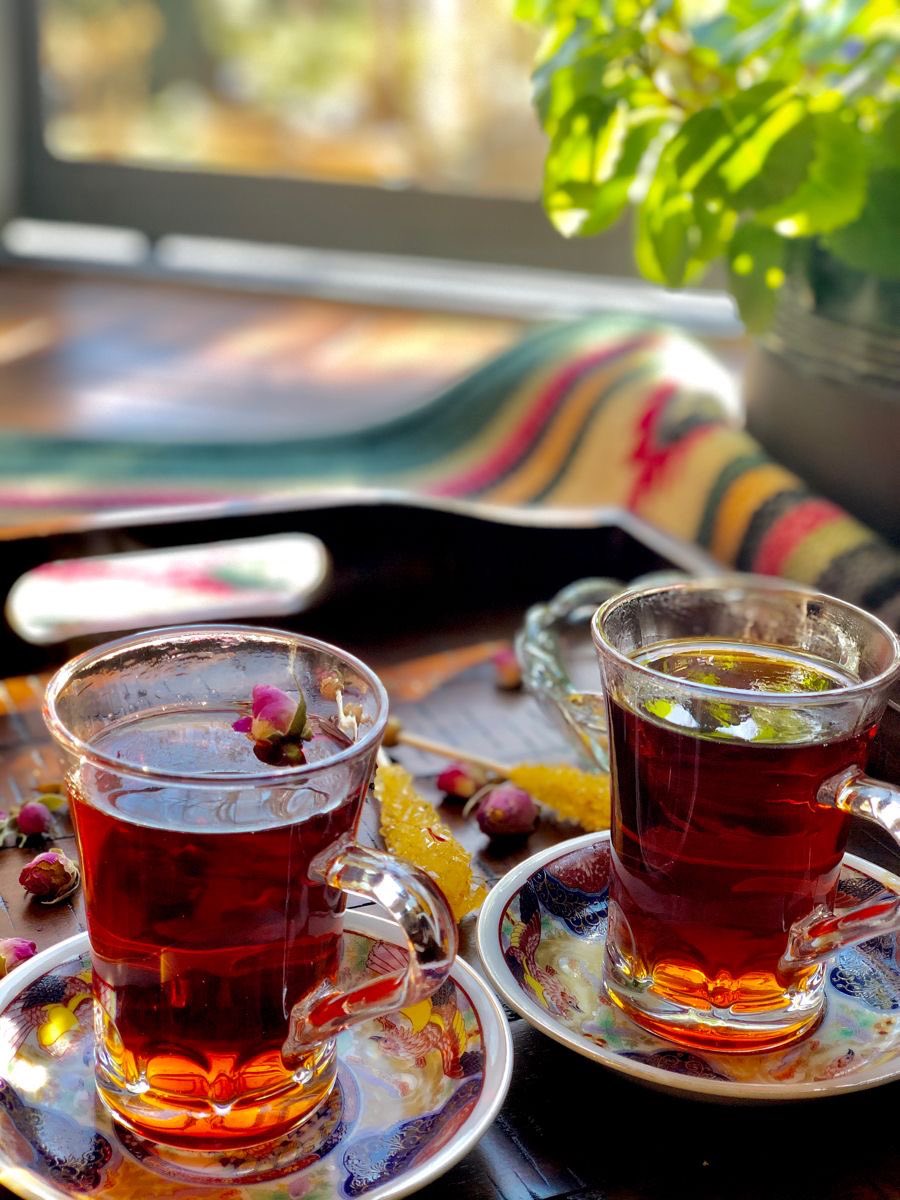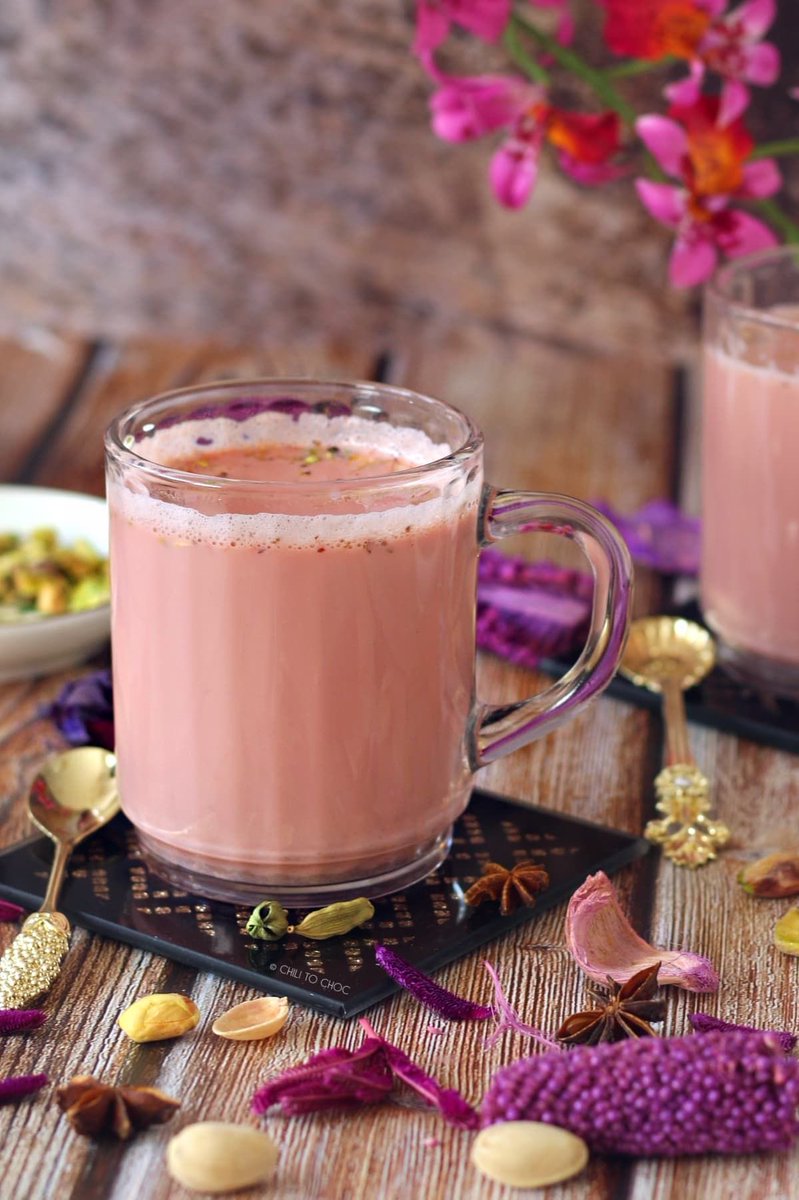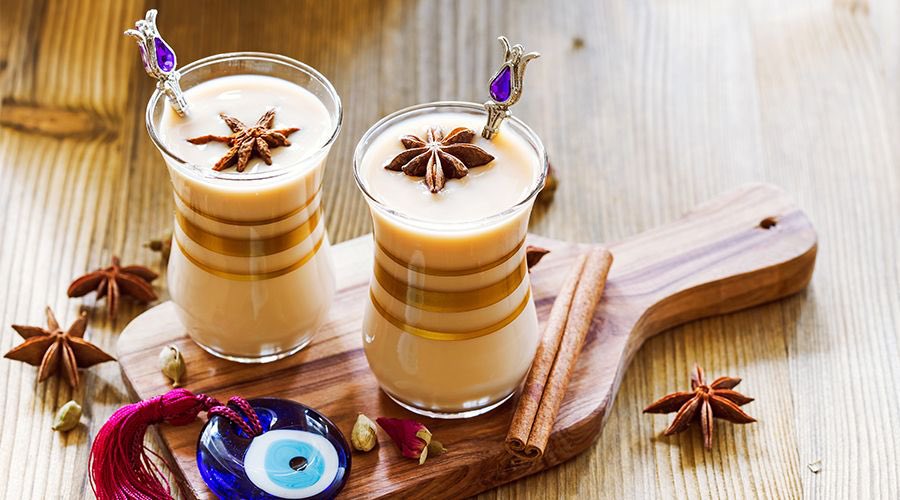In Muslim countries, tea is more than just a hot drink. It is very important to the heritage, traditions and cultures in which it originates.
For #InternationalTeaDay we celebrate the art of tea, with 24 different types of tea from across the Muslim world…
A thread…
For #InternationalTeaDay we celebrate the art of tea, with 24 different types of tea from across the Muslim world…
A thread…

1/ Somali Shaah
A spiced black chai made throughout Somalia. It is found across the Somali diaspora & is a cousin of Yemeni, Kenyan & Indian chais. It differs from other chais in that it often omits black pepper, & the milk is added after the cooking process #InternationalTeaDay
A spiced black chai made throughout Somalia. It is found across the Somali diaspora & is a cousin of Yemeni, Kenyan & Indian chais. It differs from other chais in that it often omits black pepper, & the milk is added after the cooking process #InternationalTeaDay

2/ Persian Chai
Black tea, called chai in Farsi, is one of the most popular drinks in Iran. It is so popular that it is more than just a drink – it is part of Persian culture. Black tea leaves are boiled with cardamom pods for the perfect Persian chai #InternationalTeaDay
Black tea, called chai in Farsi, is one of the most popular drinks in Iran. It is so popular that it is more than just a drink – it is part of Persian culture. Black tea leaves are boiled with cardamom pods for the perfect Persian chai #InternationalTeaDay

3/ Yemeni Shai Adeni
Shai Adeni (Shahi Mulaban, Shahi Haleeb, Arabic Shai, Adeni Tea) is a Yemeni tea from the coastal city of Aden flavored with cinnamon, cardamom, cloves, and sweetened condensed milk or evaporated milk with a bit of sugar #InternationalTeaDay
Shai Adeni (Shahi Mulaban, Shahi Haleeb, Arabic Shai, Adeni Tea) is a Yemeni tea from the coastal city of Aden flavored with cinnamon, cardamom, cloves, and sweetened condensed milk or evaporated milk with a bit of sugar #InternationalTeaDay

4/ Egyptian Koshary Shai
Generally the preferred tea in the northern part of Egypt. It is a lighter tea, that is prepared by the steeping tea leaves in hot water. Sugar is added in copious amounts. Sometimes, mint leaves are added to make the tea refreshing #InternationalTeaDay
Generally the preferred tea in the northern part of Egypt. It is a lighter tea, that is prepared by the steeping tea leaves in hot water. Sugar is added in copious amounts. Sometimes, mint leaves are added to make the tea refreshing #InternationalTeaDay

5/ Indian Masala Chai
Masala means spice, and chai means tea. Therefore, masala chai means tea with spices. It's typically made of loose leaf black tea like assam, whole milk, a variety of fragrant and warming spices including cloves & cinnamon, and sugar #InternationalTeaDay
Masala means spice, and chai means tea. Therefore, masala chai means tea with spices. It's typically made of loose leaf black tea like assam, whole milk, a variety of fragrant and warming spices including cloves & cinnamon, and sugar #InternationalTeaDay

6/ Z-hourat, Lebanon & Syria
A popular herbal tea made from a blend of aromatic herbs. This tea is the perfect combination of rich herbs, fragrant smells & goodness. It includes dried Rose petals, Lavender, Hibiscus, Chamomile, Thyme, Sage & Mint #InternationalTeaDay
A popular herbal tea made from a blend of aromatic herbs. This tea is the perfect combination of rich herbs, fragrant smells & goodness. It includes dried Rose petals, Lavender, Hibiscus, Chamomile, Thyme, Sage & Mint #InternationalTeaDay

7/ Afghani Kahwah
A combination of green tea, cardamom pods, cinnamon bark & saffron strands. It may also include peppercorns, ginger & almonds. Each family has their own recipe passed down from generation to generation #InternationalTeaDay
A combination of green tea, cardamom pods, cinnamon bark & saffron strands. It may also include peppercorns, ginger & almonds. Each family has their own recipe passed down from generation to generation #InternationalTeaDay

8/ Saudi Finjan Erfeh
A spicy zesty tea from Saudi Arabia. Made with black tea leaves, anise seeds, honey, lemon juice and sugar #InternationalTeaDay
A spicy zesty tea from Saudi Arabia. Made with black tea leaves, anise seeds, honey, lemon juice and sugar #InternationalTeaDay

9/ Kashmiri Tea
Often called Pink Tea, Kashmiri chai is a milk tea characterized by its dusty pink color and garnishing of crushed nuts. It's brewed with green tea leaves and baking soda, and then mixed with milk to give it a distinct pink colour #InternationalTeaDay
Often called Pink Tea, Kashmiri chai is a milk tea characterized by its dusty pink color and garnishing of crushed nuts. It's brewed with green tea leaves and baking soda, and then mixed with milk to give it a distinct pink colour #InternationalTeaDay

10/ Palestinian Shay bil Maramiya (شاي بالمرامية)
Made by steeping black tea leaves with dried sage. It takes less than 10 minutes from start to finish and is a common treatment for stomach aches. A little sugar is mixed in as desired #InternationalTeaDay
Made by steeping black tea leaves with dried sage. It takes less than 10 minutes from start to finish and is a common treatment for stomach aches. A little sugar is mixed in as desired #InternationalTeaDay

11/ Turkish Tea
Turks use curved, tulip-shaped tea glasses on a small saucer to serve their traditional delicious popular black tea, which has a unique slightly bitter taste, and is sweetened with sugar #InternationalTeaDay
Turks use curved, tulip-shaped tea glasses on a small saucer to serve their traditional delicious popular black tea, which has a unique slightly bitter taste, and is sweetened with sugar #InternationalTeaDay

12/ Mauritian Tea
Black tea is the traditional choice in Mauritius, however, the locally-produced vanilla tea is a firm favourite. In Mauritius, tea is usually served sweet, with a hefty dose of powdered milk #InternationalTeaDay
Black tea is the traditional choice in Mauritius, however, the locally-produced vanilla tea is a firm favourite. In Mauritius, tea is usually served sweet, with a hefty dose of powdered milk #InternationalTeaDay

13/ Iraqi Chai
Prepared in a special way boiling tea in hot water, then placing it over a second tea pot with boiling water to let the tea infuse. Iraqi tea is renowned for being a lot stronger, richer & sweeter than those found in neighbouring countries #InternationalTeaDay
Prepared in a special way boiling tea in hot water, then placing it over a second tea pot with boiling water to let the tea infuse. Iraqi tea is renowned for being a lot stronger, richer & sweeter than those found in neighbouring countries #InternationalTeaDay

14/ Moroccan Mint Tea
Made by steeping green tea with a generous handful of spearmint leaves, it is sometimes also made with other types of mint or herbs, and traditionally served in small glass cups #InternationalTeaDay
Made by steeping green tea with a generous handful of spearmint leaves, it is sometimes also made with other types of mint or herbs, and traditionally served in small glass cups #InternationalTeaDay

15/ Sudanese Cinnamon Tea
A blend of black tea steeped with cinnamon sticks. Many people like to hold a sugar cube between the teeth while drinking to sweeten the brew #InternationalTeaDay
A blend of black tea steeped with cinnamon sticks. Many people like to hold a sugar cube between the teeth while drinking to sweeten the brew #InternationalTeaDay

16/ Kuwaiti tea (Arabic: الشاي الكويتي; "Shay al Kuwaiti")
There are two popular types. One is a sweet cinnamon tea made with cinnamon sticks and sugar. Another type of Kuwaiti tea is saffron and cardamom tea. This tea is usually served after lunch #InternationalTeaDay
There are two popular types. One is a sweet cinnamon tea made with cinnamon sticks and sugar. Another type of Kuwaiti tea is saffron and cardamom tea. This tea is usually served after lunch #InternationalTeaDay

17/ Uzbek Tea
Tea is the main drink in Uzbekistan. Any meal starts with Uzbek tea and ends with it. The most popular is green tea (kuk-choy). Black tea (kora-choy) is most popular in Tashkent. Generally, Uzbek tea is taken without sugar #InternationalTeaDay
Tea is the main drink in Uzbekistan. Any meal starts with Uzbek tea and ends with it. The most popular is green tea (kuk-choy). Black tea (kora-choy) is most popular in Tashkent. Generally, Uzbek tea is taken without sugar #InternationalTeaDay

18/ Omani Spiced Milk Tea
Called Special Karak in Oman, this sweet milk tea is spiced with cardamom, clove, cinnamon, and ginger. Sweetened condensed milk brings intense creaminess #InternationalTeaDay
Called Special Karak in Oman, this sweet milk tea is spiced with cardamom, clove, cinnamon, and ginger. Sweetened condensed milk brings intense creaminess #InternationalTeaDay

19/ Ethiopian Spiced Shahee
This is more of an infusion than a true tea, since it isn't made with tea leaves. It is made using ground cardamom, ground cinnamon, ground nutmeg, ground cloves and a slice fresh ginger boiled together #InternationalTeaDay
This is more of an infusion than a true tea, since it isn't made with tea leaves. It is made using ground cardamom, ground cinnamon, ground nutmeg, ground cloves and a slice fresh ginger boiled together #InternationalTeaDay

20/ Teh Tarik Pulled tea, Singapore & Malaysia
A hot milk tea, like Karak Chai, but with a twist. It is popular in countries like Singapore and Malaysia. A unique technique goes into making this tea, and it gets its name from it too, 'pulled tea' #InternationalTeaDay
A hot milk tea, like Karak Chai, but with a twist. It is popular in countries like Singapore and Malaysia. A unique technique goes into making this tea, and it gets its name from it too, 'pulled tea' #InternationalTeaDay

21/ Indian Karak Chai
A traditional tea that is rich in flavor. The word karak literally means strong, and hence you know that the flavor is going to pack a punch! Made with black tea, sweetened condensed milk, freshly ground cardamom, sugar, and saffron #InternationalTeaDay
A traditional tea that is rich in flavor. The word karak literally means strong, and hence you know that the flavor is going to pack a punch! Made with black tea, sweetened condensed milk, freshly ground cardamom, sugar, and saffron #InternationalTeaDay

22/ Bangladeshi Tandoori Chai
It’s made by taking iron tongs to place an earthen cup in a hot tandoor. When the cup is super-hot, it’s taken out and sweet milky chai is poured in, which sizzles & froths over. This chai is poured into another kulhad & served. #InternationalTeaDay
It’s made by taking iron tongs to place an earthen cup in a hot tandoor. When the cup is super-hot, it’s taken out and sweet milky chai is poured in, which sizzles & froths over. This chai is poured into another kulhad & served. #InternationalTeaDay

23/ Persian style black tea with dried lime

This type of tea is popular with Iranians. It consists of black tea leaves and dried lime. Dried lime is a lime that has dried in the sun #InternationalTeaDay

This type of tea is popular with Iranians. It consists of black tea leaves and dried lime. Dried lime is a lime that has dried in the sun #InternationalTeaDay

24/ Keralan Sulaimani Chai
From the Indian state of Kerala it is popular in the UAE too. Sulaimani chayya, is a mild tea made with loose tea leaves & flavoured with lemon or mint. According to folklore, Sulaimani tea is believed to have Arab origins #InternationalTeaDay
From the Indian state of Kerala it is popular in the UAE too. Sulaimani chayya, is a mild tea made with loose tea leaves & flavoured with lemon or mint. According to folklore, Sulaimani tea is believed to have Arab origins #InternationalTeaDay

• • •
Missing some Tweet in this thread? You can try to
force a refresh






















